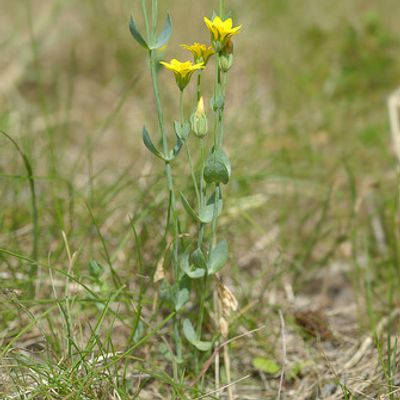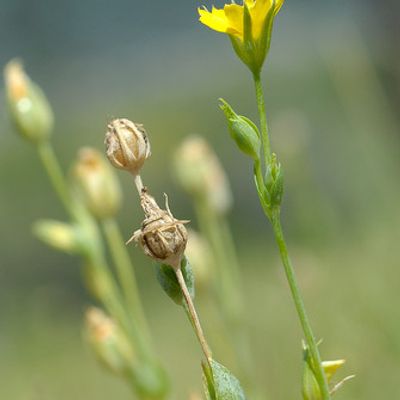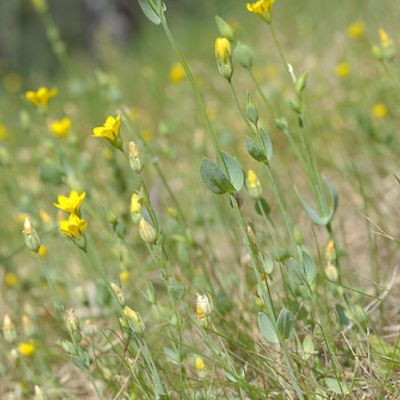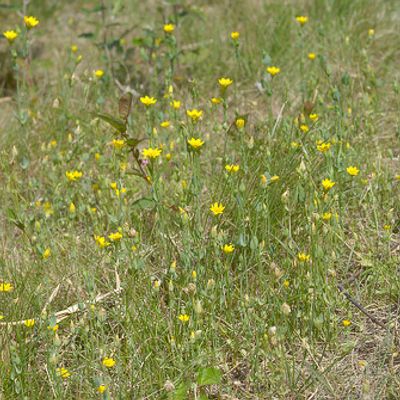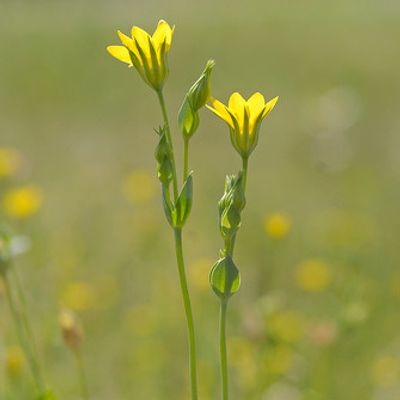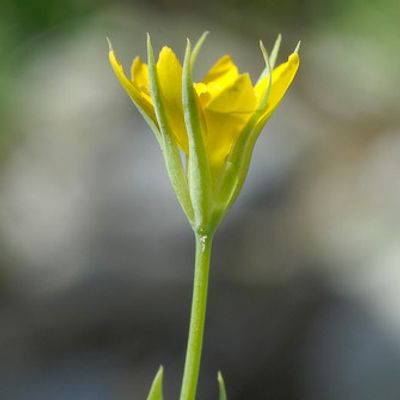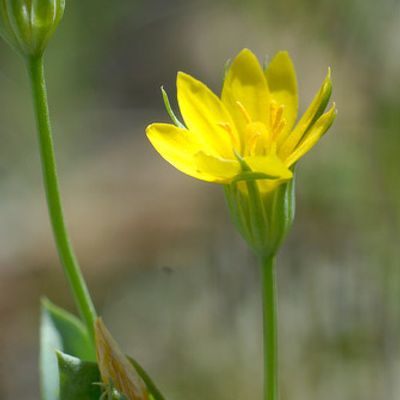Blackstonia acuminata (W. D. J. Koch & Ziz) Domin
1006850
Species
ISFS : 62300
Checklist : 1006850
ISFS : 62300
Checklist : 1006850
Contains :
Synthesis
Species description (© Flora Helvetica 2018)
Ähnlich wie B. perfoliata, aber Stängelblätter an der Basis deutlich verschmälert und nur geringfügig verwachsen, Blütenstiele meist ca. 2 cm, aber auch bis 7 cm lang (bei B. perfoliata meist ca. 1 cm, höchstens 3 cm), Kelchblätter der Frucht eng anliegend, einzelne immer breiter als 1 mm.Flowering period (© Flora Helvetica 2018)
8-10Habitat and distribution inside Switzerland (© Flora Helvetica 2018)
Wechselfeuchte Orte, Ufer, Gräben / kollin / VS, VD, GEWorld distribution (© Flora Helvetica 2018)
MediterranEcological indicator (© Landolt & al. 2010)
3+w+41+44+4.t.2n=40Status
IUCN status
EndangeredNational Priority
2 - high national priorityInternational responsibility
2 - mediumConservation
Threats
Sukzession, Fehlen von regelmässigen Bodernstörungen
Verbuschung, Aufgabe der bestehenden Nutzung (Mahd, extensive Pferdeweide u. a.)
Zerstörung des Lebensraumes (Auffüllung, Entwässerung u. a.), Deponien, touristische Aktivitäten (z. B. Motocross), Militär
Wenige, isolierte Populationen
Distribution map
Habitat and distribution inside Switzerland
VS, VD, GEWorld distribution
MediterranEcology
Life form
Therophyte
Habitats
Milieux Phytosuisse (© Prunier et al. 2017)
Habitats © Delarze & al. 2015
 | 2.5.1 - Einjährige Schlammflur (Zwergbinsenflur) (Nanocyperion) |
bold
Dominant species, influencing the appearance of the habitat
 Character species
Character species
 Less strictly linked to a specific habitat
Less strictly linked to a specific habitat
Ecological indicator values by © Landolt & al. (2010)
| Soil factors | Climatic factors | Salinity tolerance | |||
|---|---|---|---|---|---|
| Humidity Value H | 3+w+ | Light Value L | 4 | Salinity Index | 1 |
| Reaction Value R | 4 | Temperature factor T | 4+ | ||
| Nutriments value N | 1 | Continentality K | 4 | ||
- Ecological values legend
Humidity Value H 1 very dry 1+ dry 2 moderatly dry 2+ moist 3 medium wet 3+ wet 4 very wet 4+ soggy 5 submerged or underwater f plants living in running water u mostly submerged plants v partly submerged, partly floating plants w humidity moderately variable (± scale of 1-2) w+ highly variable humidity (scale exceeding ± 2) Reaction Value R 1 Very acid (pH 2.5-5.5) 2 acid (pH 3.5-6.5) 3 lightly acid to neutral (pH 4.5-7.5) 4 neutral to basic (pH 5.5-8.5) 5 basic (pH 6-5 -> 8.5 Nutriments value N 1 very low in nutrients 2 low in nutriments 3 medium-poor to medium-rich in nutrients 4 rich in nutriments 5 very rich in nutriments Salinity tolerance 1 halotolerant 3 halophyle Light Value L 1 very shady 2 shady 3 lighted areas 4 luminous 5 highly luminous Temperature factor T 1 alpine to nival stages (from the treeline to the snowline) 1+ suprasubalpine and upper subalpine levels (pine and larch forests) 2 subalpine level (coniferous forests without beeches up to the upper limit of spruces) 2+ lower subalpine and upper mountain stages 3 mountain level (beech and silver fir forests, in the central Alps Scots pine forests) 3+ lower mountain and upper hill levels 4 hill level (mixed deciduous oak forests) 4+ hot places, hill level 5 very hot places, hill level (only in the hottest places, typical of southern Europe) Continentality K 1 Atlantic (high air humidity, very low temperature variations, mild winters) 2 Sub-Atlantic (high air humidity, low temperature variations, relatively mild winters) 3 sub-Atlantic to subcontinental (average air humidity, moderately variable temperature, slightly low winter temperatures) 4 subcontinental (low air humidity, large temperature variations, rather cold winters) 5 continental (very low air humidity, very large temperature variations, cold winters)
Water dependency
| Rivers | 0 - No link |
| Calm water | 2 - Essential habitat |
| Ground water | 0 - No link |
Nomenclature
Accepted Name (Checklist 2017)
Blackstonia acuminata (W. D. J. Koch & Ziz) Domin
Vernacular name
Deutscher Name :
Spätblühender BitterlingNom français :
Blackstonie acuminéeNome italiano :
Centauro acuminatoMatch with other reference books
| Relation | Nom | Book | No |
|---|---|---|---|
| = | Blackstonia acuminata (W. D. J. Koch & Ziz) Domin | Checklist 2017 | 62300 |
| = | Blackstonia acuminata (W. D. J. Koch & Ziz) Domin | Flora Helvetica 2001 | 1504 |
| = | Blackstonia acuminata (W. D. J. Koch & Ziz) Domin | Flora Helvetica 2012 | 1398 |
| = | Blackstonia acuminata (W. D. J. Koch & Ziz) Domin | Flora Helvetica 2018 | 1398 |
| = | Blackstonia acuminata (W. D. J. Koch & Ziz) Domin | Index synonymique 1996 | 62300 |
| = | Blackstonia acuminata (W. D. J. Koch & Ziz) Domin | Landolt 1977 | 2396 |
| = | Blackstonia acuminata (W. D. J. Koch & Ziz) Domin | Landolt 1991 | 1946 |
| = | Blackstonia acuminata (W. D. J. Koch & Ziz) Domin | SISF/ISFS 2 | 62300 |
| = | Blackstonia acuminata (W. D. J. Koch & Ziz) Domin | Welten & Sutter 1982 | 1278 |
= The taxon corresponds to the accepted taxon (Checklist 2017)
< The taxon is included in the accepted taxon (Checklist 2017)
> The taxon includes (among others) also the accepted taxon (Checklist 2017)
< The taxon is included in the accepted taxon (Checklist 2017)
> The taxon includes (among others) also the accepted taxon (Checklist 2017)
Status
Native status
-IUCN list of endangered species (© Walter & Gillett 1997) : No
Status on national Red List 2016
IUCN status:
Endangered

Additional information
IUCN criteria: B2b(iii)c(iii)
Status on regional Red List 2019
| Biogregraphic regions | Status | IUCN criteria |
|---|---|---|
| Jura (JU) | RE | |
| Mittelland (MP) | CR | B2b(iii)c(iii) |
| Alpennordflanke (NA) | CR | B2b(iii)c(iii) |
| Alpensüdflanke (SA) | -- | |
| Östliche Zentralalpen (EA) | -- | |
| Westliche Zentralalpen (WA) | EN | B2b(iii)c(iii) |
- Legend
EX Extinct RE Regionally Extinct CR(PE) Critically Endangered, Probably Extinct CR Critically Endangered EN Endangered VU Vulnerable NT Near Threatened LC Least Concern DD Data Deficient NE Not Evaluated NA Not Applicable
National Priority Species List Status
| National Priority | 2 - high national priority |
| Need to take action | 2 - |
| International responsibility | 2 - medium |
| Need to monitor populations | 2 - |
Protection status
| International (Bern Convention) | No | |
| GE | total protection | (25.07.2007) |
| SH | total protection | (06.03.1979) |
| Switzerland | -- | |
| VD | total protection | (02.03.2005) |
| ZH | partial protection | (03.12.1964) |
- Disclaimer
InfoFlora compiles information on protected species as accurately as possible, taking it from the respective cantonal laws. In some cases, however, it was not possible to use the plant names as listed in the original text, but an interpretation of their taxonomy or nomenclature was necessary. The exact meaning of the categories „completely protected“ and „partially protected“ differs among the cantons.
InfoFlora cannot guarantee that the information on the protection status is correct and complete. In case of doubts, we recommend to look up the texts of the respective cantonal law.
Status by sector of activity
| Agriculture-related environmental objectives : | more informations | |
| Forest management environmental objectives : | more informations |
Conservation
Threats and measures
Sukzession, Fehlen von regelmässigen Bodernstörungen
Offene, niedrige Vegetation an den Fundstellen gewährleisten
Pionierlebensräume schaffen (z. B. Ersatzmassnahmen im Rahmen von UVPs)
Verbuschung, Aufgabe der bestehenden Nutzung (Mahd, extensive Pferdeweide u. a.)
Entbuschen
günstige, bestehende extensive Nutzungen erhalten und z. B. mittels Ökobeiträgen fördern
Zerstörung des Lebensraumes (Auffüllung, Entwässerung u. a.), Deponien, touristische Aktivitäten (z. B. Motocross), Militär
Schutz der bestehenden Populationen
keine Auffüllungen, Deponien
Nutzungen, welche offene Lebensräume schaffen, kontrolliert zulassen
Wenige, isolierte Populationen
Der Dynamik entsprechendes Management von Fundstellen
regelmässige Bestandeskontrolle
Dauerflächen-Beobachtung
Wiederansiedlung (aus Samen) in Ersatzbiotopen in ehemaligen Fundgebieten
Erfolgskontrolle der Massnahmen gewährleisten

